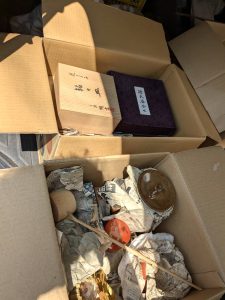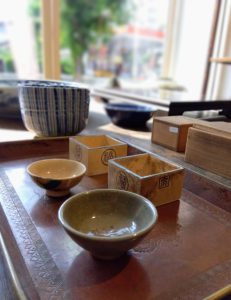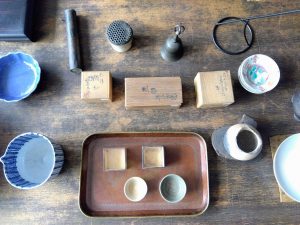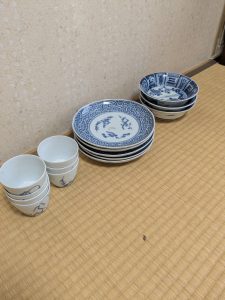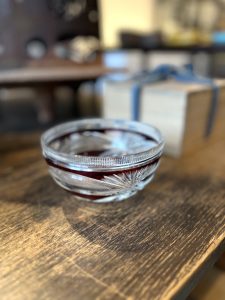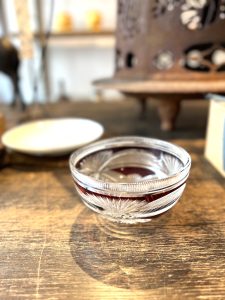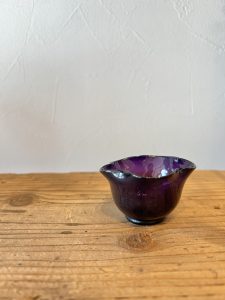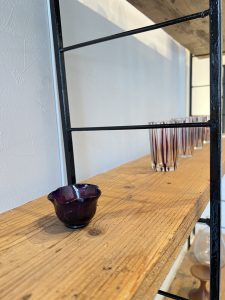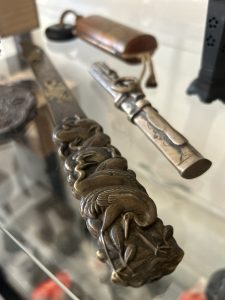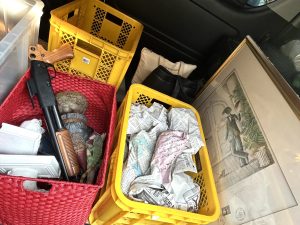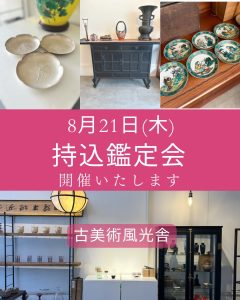最上級を意味する「醍醐」とは(愛知県名古屋市千種区姫池通 骨董買取 古美術風光舎)
2025.08.26
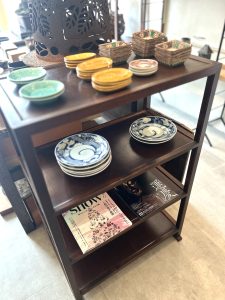
先日大河ドラマ「べらぼう」を観ておりましたら、「醍醐」という食べ物が出てきました。白い羊羹のような艶々した食べ物に目が釘付けになりストーリーが頭に入ってこないので、とりあえず「醍醐」なる食べ物を調べてみました。
醍醐は「醍醐味」や「醍醐寺」などの語源となる食べ物で、牛乳を発酵させて固めたチーズのようなものだそうです。古代のチーズというと飛鳥時代につくられた「蘇(そ)」が思い浮かびます。
現在でも古代の味を体験しようという試みから、「蘇」にちなんだ食べ物が奈良県内のホテルやカフェなどで提供されており、商品開発も進んでいるのだとか。「蘇」とは、孝徳天皇の時代に渡来人により献上されたとされる牛乳を約10分の1に煮詰めた加工品です。ミネラルやビタミンなどの栄養素が豊富で薬のようなものだったともいわれています。何時間も牛乳を煮詰めるのは当時としては大変な労力で、権力のある人物しか口にできなかったようです。藤原道長が体調が優れない時に好んで食べていたという話もあるとのこと。
その「蘇」をさらに精製したものが「醍醐」となり、バターのような風味を持つ最高級の乳製品とされていました。
仏教の「涅槃経」において釈尊の教えを分かりやすく説明するために「牛乳を精製する際の五段階の味」とされる「五味」の変化を例として用いたとのこと。五味とは段階的に「乳味→牛乳の味」、「酪味→発酵乳の味」、「生酥味→サワークリームの味」、「熟酥味→発酵バターの味」、「醍醐味→バターオイルの味」へと変化し、五味の中でも味を極めた醍醐を「涅槃経」に例えることにより涅槃経が最上級の教えだと説いたのだとか。
そこから醍醐味は「真の魅力」「最大の喜びや楽しみ」という意味合いで使われるようになりました。醍醐天皇や醍醐寺などの名前にも繋がっています。
発酵バターまでは何とか想像できますが、バターオイルとは?チーズのような味わいでしょうか。古の日本人を魅了した極上のチーズのような「醍醐」の味とはどのようなものだったのでしょうか。
世界に目を向けると今から約5000年前、紀元前2800年頃には既にチーズは存在したとされています。動物の胃袋の中に保存されていた牛乳が個体と液体に分離されチーズの元になったという民話が残されているそうです。個体となったチーズは保存がきくということから世界中に広まり、今では1000種類以上のチーズがあるとされています。
私もチーズは好きな方ですが、食べたことがあるのは僅かです。日本では多様なチーズに出会うのはなかなか難しいかもしれません。
最近我が家で夏に一回だけ楽しむのが桃とブラーター(ブッラータ?)チーズのサラダです。オリーブオイルや塩だけの簡単な味付けですが、桃とブラーターチーズがよく合います。蜂蜜をかけてデザートとして食べるのも美味しいそうです。
ブラータというのは「バターのような」というイタリア語で、モッツアレラチーズと生クリームを合わせたものをモッツアレラチーズの皮で包んだものです。皮にナイフを入れるとトロッとしたチーズが出てきます。余ったモッツアレラチーズの有効活用から生まれたようですが、その美味しさから各地で製造されるようになったのだとか。鮮度を保つのが難しく、手間がかかり、製造の難易度の高いことから値段がちょっとお高めなので夏に一度だけ特別メニューとしていただきます。
そういえば我が家では大して手間のかからない料理を、年に1回の特別料理と称して出すことが多い気がします。
手間を掛けず楽をして頑張っている感を演出できるから…かもしれません。
それでは、また次の機会に、(スタッフH)
The other day, while watching the historical drama “Berabou,” I came across a food called “Daigo.” I was so captivated by this shiny, white, mochi-like food that I couldn’t concentrate on the story, so I decided to look up what “Daigo” was.
Daigo is a food that is the origin of terms like “daigo-mi” (the essence of something) and “Daigo-ji” (a temple), and it’s apparently a cheese-like food made by fermenting milk and solidifying it. When I think of ancient cheese, I imagine “so,” a cheese made during the Asuka period.
Even today, there are efforts to experience the taste of ancient times, and foods inspired by “so” are being served at hotels and cafes in Nara Prefecture, with product development also progressing. “So” is a processed product made by boiling down milk to about one-tenth of its original volume, said to have been presented by immigrants during the reign of Emperor Kōtoku. It was rich in minerals and vitamins and was said to be like medicine. Boiling down milk for hours was a tremendous effort at the time, and it seems only those in power could afford to eat it. There is also a story that Fujiwara no Michinaga enjoyed eating it when he was unwell.
The further refined version of “Sō” is called “Daigo,” which was considered the highest-quality dairy product with a butter-like flavor.
In the Buddhist “Nirvana Sutra,” the “five tastes” of milk during the refining process were used as an example to explain the teachings of the Buddha in an easy-to-understand manner. The five tastes are: “milk taste,” “fermented milk taste,” “raw butter flavor → the flavor of sour cream,” “ripe butter flavor → the flavor of fermented butter,” and “daigo flavor → the flavor of butter oil.” By comparing daigo, which represents the pinnacle of flavor among the five flavors, to the Nirvana Sutra, it was said to symbolize the highest teachings.
From there, the term “daigo” came to be used to mean “true charm” or “the greatest joy or pleasure.” It is also connected to the names of Emperor Daigo and Daigo-ji Temple.
While I can somehow imagine fermented butter, what about butter oil? Is it similar to the taste of cheese? What was the taste of “daigo,” which captivated the ancient Japanese like the finest cheese?
Looking at the world, cheese is said to have already existed around 5,000 years ago, around 2800 BCE. There is a folk tale that milk stored in an animal’s stomach separated into solids and liquids, forming the basis of cheese. The solid cheese, which could be preserved, spread throughout the world, and today there are said to be over 1,000 types of cheese.
I also like cheese, but I have only eaten a few types. It may be difficult to encounter a variety of cheeses in Japan.
Recently, my family enjoys a salad of peaches and burrata (or burrata?) cheese once a year in the summer. It is simply seasoned with olive oil and salt, but the peaches and burrata cheese go well together. It is also delicious when eaten as a dessert with honey.
Burrata means “butter-like” in Italian, and it is made by combining mozzarella cheese and cream, then wrapping it in mozzarella cheese skin. When you cut into the skin with a knife, the creamy cheese oozes out. It seems to have originated as a way to make use of leftover mozzarella cheese, but its deliciousness spread to various regions. It is difficult to maintain its freshness, requires a lot of effort, and is difficult to manufacture, so it is a bit expensive. We enjoy it as a special menu item once a year in the summer.
Come to think of it, at our house, we often serve dishes that don’t require much effort as “special dishes” once a year.
I just realized that it’s because it makes us feel like we’re working hard while actually taking it easy.
Well, until next time. (Staff H)
*******************
ご実家の整理やお片付けなどをされている方のご相談などが多くございます。
お片付けなどくれぐれもご無理のないようになさってくださいませ。
風光舎では古美術品や骨董品の他にも絵画や宝石、趣味のお品など様々なジャンルのものを買受しております。
お片付けをされていて、こういうものでもいいのかしらと迷われているものでも、どうぞお気軽にご相談下さいませ。
また風光舎は、出張買取も強化しております。ご近所はもちろん、愛知県内、岐阜県、三重県その他の県へも出張いたします。
まずは、お電話お待ちしております。
愛知県名古屋市千種区姫池通
骨董 買取【古美術 風光舎 名古屋店】
TEL052(734)8444
10:00-18:00 OPEN


